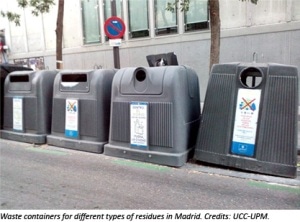Jun 30 2017
After performing a systematic evaluation process of the urban containerization system, Researchers from Universidad Politécnica de Madrid concluded that an unsuitable design of a container system might needlessly worsen the impact on the environment when gathering and transporting the urban waste.

The developed process, which can be extrapolated to other cities and regions, allows assessment of the current differences among the administrative units in which a territory is divided, to detect irregularities and recommend corrective measures to reduce the impact on the environment when gathering urban waste.
Municipal solid waste (MSW) management includes stages such as: collection, transport and treatment. They involve a variety of technical operations that rely on the existence of selective collection systems for the different fractions, which are commonly paper/cardboard, packaging, glass, organic waste and mixed waste. Each of these stages has environmental impacts due to the use of bags to dispose the waste generated by households, from the use of lorries or systems to transport the waste to the processing point, from the containers placed in public roads for drop-off, and from the construction and operation of plants to treat each waste fraction.
The environmental impact assessment linked to each stage is performed through the life cycle assessment which allows a systemic, objective and scientific evaluation of its influence on the environment and human health.
While the transport and final treatment of MSW have been broadly examined, there are few works that apply the life cycle to the collection either as a part of analysis of the unified management system. Besides, the occasional studies fail to take into consideration aspects regarding contribution, endowment, or effectiveness of the containerization system that defines the environmental impact.
This research, developed by the research group of Environmental Technologies and Industrial Resources at UPM, looks into this gap by concentrating on the collection, the stage in which containers are at disposal of citizens.
The method establishes the environmental impact linked to the total containerization of a city, as well as for all districts. This approach has three phases: the first phase aims to collect detailed data of the city. The second phase evaluates the life cycle of each container, and finally the third phase collates the results for the geographic scope of the research which is based on the results acquired during the second phase and drawing the inferences based on the estimated indicators during the first phase.
This method has been applied to the city of Madrid (Spain) and has allowed Researchers to define the environmental impact linked to the set of containers of the entire municipality and each districts, evaluating their differences and establishing an association among such impact, the provision of containers (liter of container per capita), and the efficacy of the collection (MSW mass collected per volume unit of containerization).
The results suggest that the installed containers in Madrid (Spain) cause a climate change impact of 3,907 tons per year of CO2 equivalent, which is 1.22 kg per inhabitant per year.
Javier Pérez, Researcher
The contribution of the containerization systems to the environmental impact caused by the MSW management is lesser than the phase of transport or treatment (1.9%, compared with 9.9 and 88.7%, respectively).
However, a bad distribution, an insufficient container capacity or an inappropriate use at the urban level, can unnecessarily aggravate environmental impact. Furthermore, the associated ineffectiveness also impacts the transport stage through pointless routes, lower average driving speeds, higher number of vehicles, or increased number of stops, resulting in higher emissions.
This research, says Javier Pérez, is part of a broader research project that they are conducting in their research group, which aims to assess the environmental impact of the MSW management in the city of Madrid. Results regarding the transport stage were also published earlier.